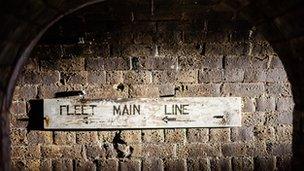Does London need a £4.2bn 'super-sewer'?
- Published
Tom Bateman explores the existing Victorian sewers
A preliminary hearing on Thursday sees the beginning of a planning inquiry into a controversial new "super-sewer" under London - which would be 15 miles (25km) long, cost £4.2bn to build and create the UK's biggest sewerage system - but do we need it?
Deep below the City of London is a world few people ever see.
Iron girders span the length of a vast subterranean space - the floor is thick with river silt and the Victorian brick walls drip with condensation.
Workers here in the Fleet mainline sewer call this the "viewing gallery" - a space the size of a church hall cut into the earth, from where you can see millions of litres of raw sewage flowing from 500,000 homes on its long journey to treatment works in the east.
The sewers are part of a 20,000-mile network owned and run by Thames Water - and are a unique piece of British history.
They were built in the 1860s by the engineer Sir Joseph Bazalgette to intercept raw sewage that previously ended up being flushed straight into the Thames.
It followed a series of outbreaks of cholera that killed 40,000 people in the first half of the 19th Century - the Victorians believed the disease was contracted through airborne "miasma" due to sewage in the open air.
Their solution was a 1,000-mile network of underground sewers, the construction of which caused much controversy thanks to the £4.2m cost (the equivalent of £430m today), but prevented sewage being dumped in the river.
It was not until after the vast project was complete that the Victorians finally understood that cholera was waterborne - the deaths had actually resulted from pumping drinking water straight from the river into which raw sewage had been flushed.
"They got the right answer to the wrong problem," says Dr Stephen Halliday, author of The Great Stink of London.
He says: "One of the things about cholera and typhoid and other waterborne diseases is that they affect everyone - they affect the rich as well as the poor," he says, explaining what drove the decision to build the Bazalgette sewers.
Bateman Tideway
"Waterborne diseases, unlike the diseases of urban filth carried by rats and fleas, [affected] members of parliament and the Royal Family as well as the poorer people, who in those days of course didn't have the vote."
Today Bazalgette's network remains in superb condition - the lack of sunlight, the moisture and the regular temperature are perfect for maintaining the Victorian brickwork, according to one worker.
But there is a problem - the sewers are being deluged.
They were built to take not only waste water from people's homes, but to act as London's drainage system - when it rains, the sewers fill up.
The population they serve has quadrupled since the 1860s and vast areas of land have been concreted or paved over.
Where storm water once drained into the earth, now it surges straight into the sewage system.
The sewers overflow on a weekly basis, flushing 39 million tonnes of raw sewage straight into the Thames each year, according to Phil Stride from Thames Water.
He says: "It is absolutely not consistent for a world-leading city to be using its river as an open sewer.
"We need to build a project that will intercept those flows and take them off to east London for treatment before they are discharged into the river," says Mr Stride, who is overseeing the Thames Tideway Tunnel project.
The 15-mile tunnel would start in Acton, west London, and follow much of the route of the river, capturing raw sewage and taking it to a pumping station in Stratford in the east of the city.
Those in the engineering business call it a "megaproject" - a 200ft (60m) deep tunnel, as wide as the Channel Tunnel, which will take 10 years to build and cost £4.2bn - nearly half the cost of the 2012 Olympics.
It would eventually add up to £80 a year to Thames Water customers' bills.
A preliminary hearing on Thursday will start the Planning Inspectorate's long inquiry process before a final decision could be taken by the government next year. If the tunnel gets the go-ahead, it is due for completion in 2026.

The Fleet mainline is named after the river that runs under Fleet Street and into the Thames
But the scheme faces strong opposition.
Much of the building work will take place around the clock, causing "mayhem" for people who live near the tunnelling sites, says Christian Sarrasin, from the environmental group, Clean Thames Now and Always.
"We've concreted over all the cities and that's why we've got this issue with the Thames Tunnel," he says.
He says there are cheaper, greener alternatives to it that involve preventing storm water flooding into the sewers in the first place.
So-called "green infrastructure" projects - often involving rooftops being covered in soil and plants - are being used extensively in the US city of Philadelphia where officials say they provide a "model" for flood and sewage management.
"You actually get massive benefits from this," says Mr Sarrasin, "it improves everybody's quality of life."
His group claims another green innovation - porous asphalt roads that soak up or store water - are a better alternative, and believe that converting half of the roads in central London would mitigate the entire need for the Thames Tunnel.
Both sides of the argument will be fully aired during the planning inquiry but there is no doubt that without some help the Victorian sewers will continue to struggle to meet the demands of 21st-Century London.
- Published31 October 2011
- Published27 October 2011
- Published29 June 2011